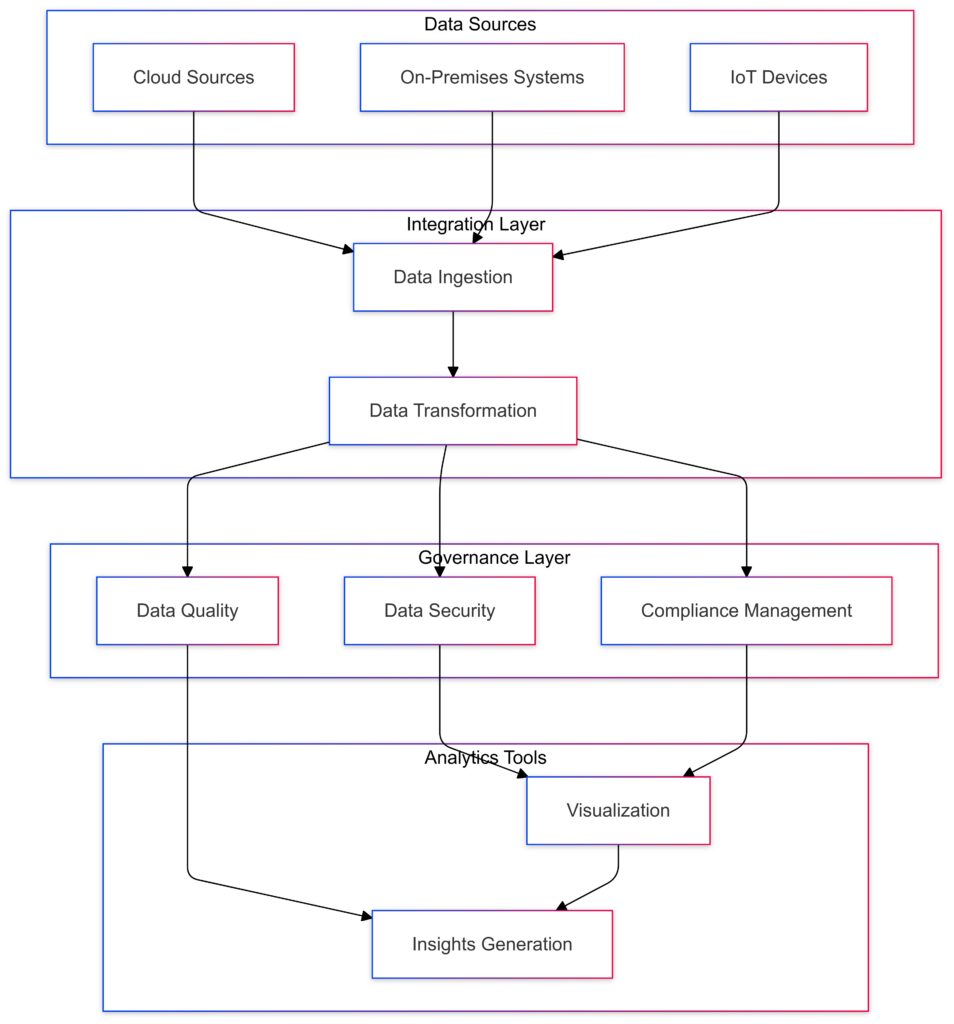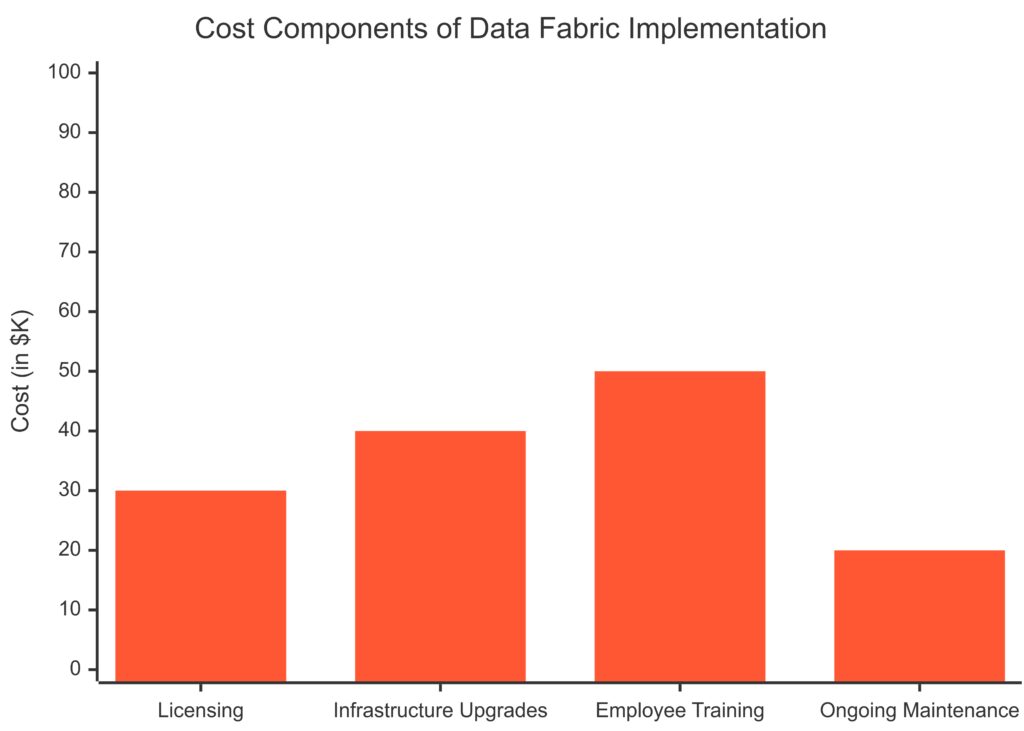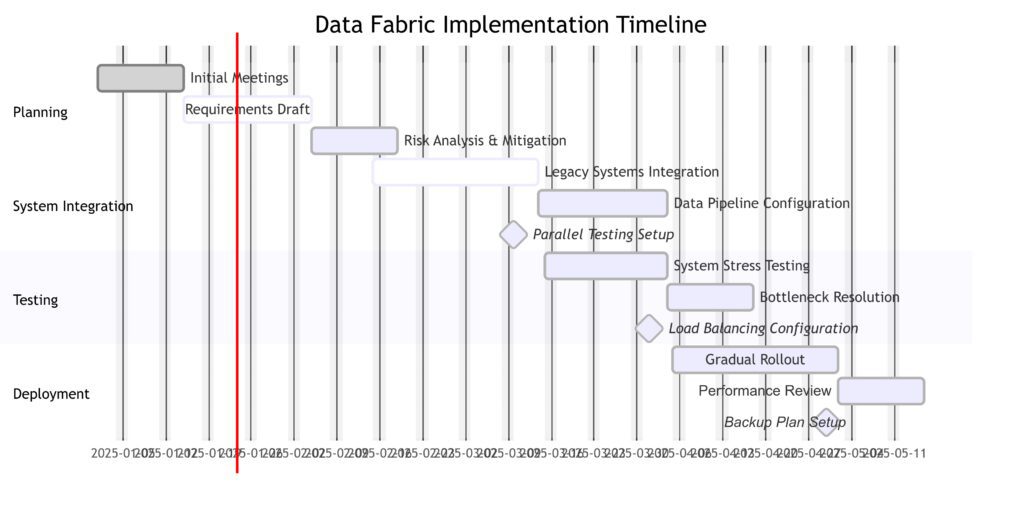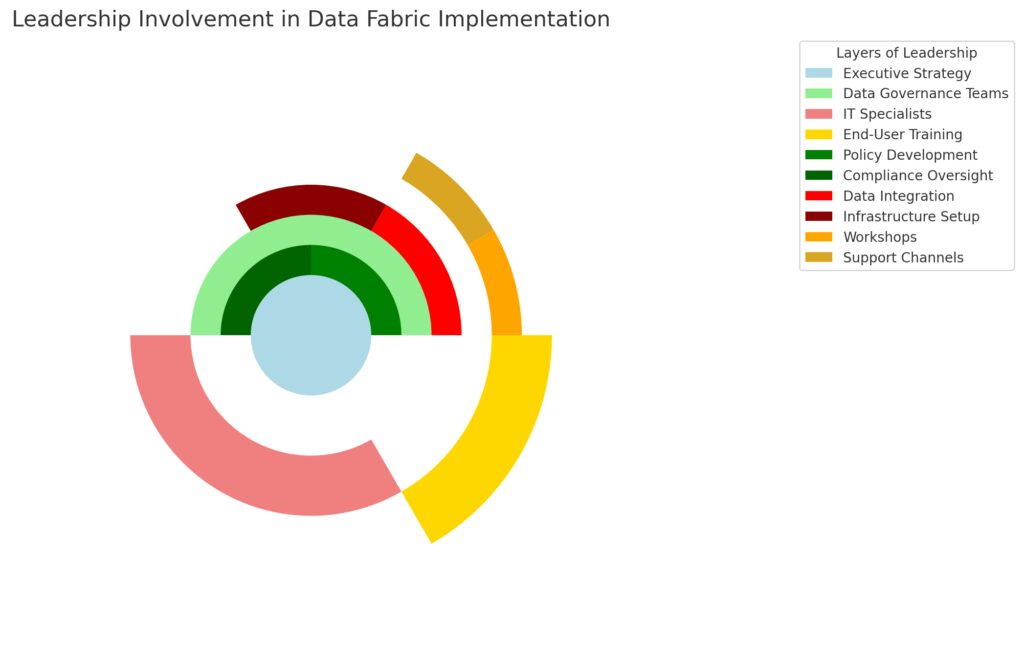
Data fabric is transforming the way organizations manage and leverage their data. But is it worth the investment? Let’s dive into the financial side of implementing data fabric, comparing the associated costs to the value it can generate.
Understanding Data Fabric and Its Core Benefits
What is Data Fabric?
Data fabric is an architectural approach that simplifies data integration across disparate systems. It enables businesses to gain real-time insights by unifying data from diverse sources.
Key features include:
- Automated data discovery and preparation.
- Improved data governance.
- Scalable architecture for handling massive datasets.
By offering a centralized solution, data fabric reduces complexities associated with siloed data, making it invaluable for organizations seeking to modernize.

The Core Benefits of Data Fabric
The value of data fabric goes beyond convenience. Here are a few critical benefits that directly impact finances:
- Faster decision-making through real-time analytics.
- Enhanced data security and compliance.
- Reduced operational inefficiencies.
These advantages make it a game-changer for companies drowning in fragmented data.
Upfront Costs of Data Fabric Implementation
Initial Investment in Tools and Technology
Adopting data fabric involves purchasing high-end tools and software. Licensing fees for platforms like Talend, Informatica, or Denodo can range from $100,000 to over $500,000 annually, depending on scale and features.
Hardware upgrades may also be required, especially for organizations with older infrastructure. Cloud-based options, though scalable, also come with recurring costs.

A breakdown of the primary costs involved in deploying data fabric solutions.
Workforce Training and Skill Development
Another significant expense is ensuring your team is equipped to manage the technology. Upskilling employees can cost upwards of $1,000 per person for training courses. Hiring specialized talent—like data architects—adds to the financial burden.
Investing in long-term skill-building, however, can offset these costs by reducing dependency on external consultants.
Operational Costs During Deployment
Data Migration and System Integration
Migrating data from legacy systems is often time-consuming and costly. Companies might face additional expenses for consulting services to ensure smooth integration. Costs can vary widely based on the size and complexity of the migration, often exceeding $50,000 for mid-sized enterprises.
Managing Downtime Risks
Implementing data fabric can lead to temporary disruptions in operations. Downtime not only affects productivity but could also result in revenue losses, especially for customer-facing businesses. Proactive planning and phased rollouts can minimize these risks.

The Long-Term Value of Data Fabric
Operational Cost Savings
Once implemented, data fabric simplifies workflows, reduces manual processes, and eliminates the need for disparate systems. This consolidation can lead to significant cost savings, freeing up resources for innovation.
Improved ROI Through Better Data Utilization
By enabling real-time insights, data fabric empowers businesses to make better decisions faster. This translates to higher returns on investments in areas like marketing, supply chain management, and customer experience.

Plateau Phase: Period of slower ROI growth as initial systems stabilize.
Accelerating Returns: ROI growth accelerates as efficiency and innovation take hold.
Quantifying Productivity Gains
Enhanced Decision-Making Efficiency
Data fabric ensures decision-makers have timely and accurate data. This can save hours—or even days—of manual effort, leading to noticeable productivity boosts.
Case Study: Cost vs. Value in Action
For example, a retail company that implemented data fabric reported a 20% reduction in operational costs and a 35% improvement in customer retention within the first year.
Balancing Risks and Rewards of Data Fabric Adoption
Evaluating Risks of Over-Investment
One common pitfall in implementing data fabric is overestimating the immediate value it will provide. Businesses may invest heavily in advanced tools without fully aligning them with their current needs.
To mitigate this, organizations should:
- Conduct a thorough needs assessment.
- Start with smaller, scalable implementations.
- Regularly evaluate ROI during each phase.
This approach ensures that the technology grows with the company, avoiding unnecessary expenses.
Potential Challenges in Adoption
Adoption hurdles often stem from:
- Resistance to change from employees.
- Unexpected technical issues during migration.
- Overwhelmed IT teams.
Addressing these issues early through proper change management and dedicated support teams reduces delays and cost overruns.
Industry-Specific Value of Data Fabric

Financial Services: Streamlining Compliance
In the heavily regulated financial sector, data fabric simplifies compliance by ensuring consistent data governance. For example, automating data lineage tracking can save millions in potential penalties.
Healthcare: Improving Patient Outcomes
Healthcare providers use data fabric to integrate patient records across systems. This improves care coordination, reduces redundant tests, and cuts overall costs—all while enhancing patient satisfaction.
Retail: Enhancing Customer Insights
Retailers benefit from real-time data integration, enabling more personalized marketing and inventory optimization. These insights can boost revenue by increasing customer retention and reducing stockouts.

Hidden Costs That Businesses Overlook
Vendor Lock-In
Choosing a proprietary platform might lead to vendor lock-in, where switching providers becomes prohibitively expensive. Open-source or hybrid solutions offer flexibility and cost control.
Maintenance and Scalability
As data grows, so do maintenance costs. Upgrades, additional storage, and network enhancements must be factored into the long-term budget. However, cloud-based solutions can provide scalable options to address this growth dynamically.
How to Maximize the Value of Data Fabric
Start with High-Impact Use Cases
Organizations should prioritize use cases with clear, measurable benefits. Examples include:
- Reducing manual reporting efforts.
- Enhancing supply chain visibility.
- Automating compliance tracking.
By focusing on these areas, businesses can achieve quick wins that justify further investment.
Leverage Automation and AI Capabilities
Data fabric platforms often integrate AI tools to automate repetitive tasks, such as data cleaning and tagging. These efficiencies save time and money, amplifying the return on investment.
The Role of Leadership in Driving Value

Data Governance Teams in light green with sub-layers (policy development in green, compliance oversight in dark green).
IT Specialists in light coral with sub-layers (data integration in red, infrastructure setup in dark red).
End-User Training in gold with sub-layers (workshops in orange, support channels in goldenrod).
Building a Culture of Data Literacy
Leadership must foster a culture where data-driven decisions are the norm. Investing in data literacy programs ensures employees at all levels can understand and utilize the technology.
Continuous Evaluation and Adaptation
Regularly reviewing the implementation’s performance helps identify gaps and opportunities for improvement. This iterative approach maximizes the long-term value of the investment.
Future Trends in Data Fabric Adoption
AI-Powered Enhancements
The integration of artificial intelligence (AI) is reshaping data fabric solutions. AI can automate:
- Data categorization.
- Anomaly detection.
- Predictive analytics for business forecasting.
These innovations reduce reliance on manual processes, driving down costs and enabling faster insights.
Rise of Multi-Cloud Strategies
Many organizations are moving toward multi-cloud environments to avoid vendor lock-in and enhance flexibility. Data fabric provides a seamless framework for integrating data across different cloud providers, ensuring consistent performance and cost management.
Expansion of Real-Time Data Use Cases
Real-time data applications, such as IoT analytics and fraud detection, are gaining prominence. Data fabric’s ability to process and analyze live streams of data makes it an essential tool for staying competitive in these areas.
Competitive Advantage with Data Fabric
Gaining Agility in a Data-Driven World
Organizations leveraging data fabric can respond to market changes faster. For example, supply chain disruptions can be mitigated by real-time monitoring and predictive insights, giving businesses a distinct edge.
Customization for Niche Markets
Data fabric’s adaptability allows businesses to tailor its implementation for industry-specific needs, such as precision agriculture in farming or smart city planning for governments.
Investing in such niche applications ensures relevance in specialized markets while maximizing profitability.
Optimizing Financial Outcomes
Prioritizing Scalable Solutions
Instead of diving into a fully-fledged data fabric setup, businesses should start small and expand based on success metrics. Modular deployments reduce financial risk while offering measurable ROI at each stage.
Collaborative Vendor Relationships
Building strong partnerships with data fabric providers can yield better support and cost-effective solutions. Negotiating customized pricing structures or collaborative R&D opportunities often leads to long-term savings.
Realizing the Full Potential of Data Fabric
Accelerating Innovation
Data fabric reduces the time spent on managing data, allowing businesses to focus on innovation. Faster prototyping, experimentation, and product launches drive profitability and market growth.
Improving Stakeholder Confidence
Transparent and unified data boosts stakeholder trust. Whether for investors, regulators, or customers, businesses with effective data management are more likely to secure funding and build brand loyalty.
Is Data Fabric Worth the Investment?
When implemented strategically, data fabric transforms how organizations manage, utilize, and benefit from their data. While upfront costs may be significant, the long-term value—from operational savings to competitive advantages—far outweighs the expenses.
Ready to invest in your data fabric journey? Focus on scalability, alignment with goals, and continuous optimization to maximize returns.
FAQs
What is the timeline for seeing financial benefits?
Most businesses start seeing financial benefits within 6 to 12 months of implementation. For example, a manufacturing firm reduced operational costs by 25% within 8 months by integrating real-time supply chain data through a data fabric platform.
What are the hidden costs of implementing data fabric?
Hidden costs may include:
- Vendor lock-in, which can limit flexibility in the long term.
- Ongoing maintenance for system upgrades and scaling.
- Employee training, which adds to upfront expenses.
An example is a healthcare provider that underestimated training costs for staff, delaying full adoption by several months.
Can data fabric help with compliance?
Yes, data fabric simplifies compliance by ensuring centralized governance and consistent reporting. A financial institution, for instance, can automatically track and log data access across systems, reducing the risk of penalties for non-compliance.
What industries benefit most from data fabric?
While almost every industry can benefit, sectors like financial services, healthcare, and retail see the most immediate gains. For example, a retailer can use data fabric to integrate customer insights across in-store and online platforms, improving personalization and boosting sales.
Is data fabric better suited for on-premise or cloud environments?
Data fabric works in both environments, but cloud-based implementations offer greater scalability and flexibility. For example, a logistics company with fluctuating data needs can use a cloud-based data fabric to adapt during peak seasons without incurring high costs.
How does data fabric compare to traditional data management systems?
Unlike traditional systems that operate in silos, data fabric provides a holistic, integrated approach to data management. A traditional system might require separate tools for analysis, but data fabric unifies these tasks, saving time and money.
What is the biggest risk of adopting data fabric?
The biggest risk is overestimating short-term gains. Without clear goals, businesses may invest in features they don’t need. For example, a startup invested heavily in a top-tier solution but only utilized 30% of its capabilities, delaying ROI.
Can data fabric support real-time data needs?
Absolutely. Data fabric is designed for real-time data processing, making it ideal for applications like fraud detection or IoT analytics. For example, a smart home device manufacturer uses data fabric to monitor device performance and send alerts for predictive maintenance.
These insights provide a clearer picture of data fabric’s financial impact and its potential to transform your business operations.
How can data fabric reduce operational costs?
Data fabric reduces operational costs by eliminating redundant systems and automating manual tasks. For example, a pharmaceutical company saved 30% on IT costs by consolidating siloed systems into a unified data fabric, streamlining research data analysis and regulatory reporting.
What role does automation play in data fabric’s financial benefits?
Automation is a core component of data fabric, reducing the need for manual data preparation and cleaning. A logistics company, for instance, automated route optimization for delivery trucks using real-time data from multiple sources, cutting fuel costs by 15%.
Does data fabric require a complete overhaul of existing systems?
No, data fabric is designed to integrate with existing infrastructure, minimizing disruption. For example, a bank used data fabric to connect its legacy systems with new analytics tools, avoiding the high cost of replacing its core infrastructure.
How do small-scale implementations of data fabric work?
Small-scale implementations focus on specific, high-value use cases. For instance, a small healthcare clinic integrated patient appointment and billing data to improve scheduling efficiency, achieving measurable ROI without a full-scale deployment.
Can data fabric help in predictive analytics?
Yes, data fabric is highly effective for predictive analytics, as it provides real-time access to unified data. A retail chain used predictive analytics powered by data fabric to anticipate seasonal demand, improving inventory management and reducing stock waste by 20%.
What’s the difference between data fabric and data mesh?
While both approaches aim to unify data, data fabric focuses on automation and centralized integration, while data mesh emphasizes a decentralized, domain-driven structure. A large enterprise with diverse departments may use data fabric to centralize governance while implementing a data mesh approach for local autonomy.
How does data fabric improve customer experience?
Data fabric enables businesses to create personalized, consistent experiences by integrating customer data across touchpoints. For example, an airline used data fabric to unify booking, loyalty, and feedback data, leading to a 25% increase in customer satisfaction scores.
Is data fabric relevant for companies without large datasets?
Yes, data fabric can benefit smaller datasets by improving data accuracy and accessibility. For instance, a boutique consulting firm streamlined reporting by integrating client data from spreadsheets and cloud platforms, reducing project delays.
How secure is data fabric?
Data fabric enhances security by centralizing access controls and ensuring compliance with regulations. For example, a government agency implemented data fabric to monitor and manage sensitive citizen data, preventing breaches and simplifying audits.
What should businesses consider before investing in data fabric?
Key considerations include:
- Defining clear goals for implementation.
- Evaluating compatibility with existing systems.
- Assessing the scalability of chosen solutions.
A manufacturing company, for example, prioritized supply chain optimization as its first use case and gradually expanded its data fabric capabilities.
Can data fabric support edge computing?
Yes, data fabric is well-suited for edge computing, providing real-time analytics at the source of data collection. For instance, a smart agriculture company used data fabric to analyze soil sensors and weather data at the edge, enabling more precise irrigation and cost savings.
How does data fabric affect innovation?
By reducing the time spent on managing data, data fabric accelerates innovation. For example, a tech startup integrated its R&D, marketing, and customer feedback data, allowing faster prototyping and shorter product development cycles.
How do I measure the ROI of data fabric?
ROI can be measured by:
- Operational savings from reduced manual tasks.
- Revenue increases from improved decision-making.
- Cost reductions from better resource allocation.
For example, a telecom company saved $1 million annually by consolidating customer support and billing data, reducing resolution times and increasing customer retention.
Resources
Comprehensive Guides on Data Fabric
- IBM’s Data Fabric Architecture Overview: IBM offers an in-depth look at the core principles of data fabric, including its benefits, use cases, and architecture. It’s an excellent starting point for understanding this technology.
IBM Data Fabric Overview - Gartner Research on Data Fabric: Gartner provides detailed reports and predictions on data fabric trends, helping organizations assess its strategic value in the long term.
Gartner Data Fabric Resources - Informatica’s Data Fabric Solutions: Informatica shares insights into how its tools can implement a data fabric strategy, along with real-world case studies.
Informatica Data Fabric Solutions
Training and Certifications
- Coursera: Data Fabric Fundamentals: This course introduces the basics of data fabric, focusing on practical implementation and real-world examples. It’s ideal for beginners.
Coursera Data Fabric Courses - Microsoft Learn: Implementing Data Fabric Solutions: Microsoft’s free learning modules cover cloud-based data fabric implementations, focusing on Azure platforms.
Microsoft Learn Data Fabric - AWS Training on Data Lakes and Fabric: AWS offers detailed resources and certifications for cloud-native data fabric architectures using AWS services.
AWS Data Fabric Training
Tools and Software for Data Fabric
- Talend Data Fabric: Talend provides a robust platform for building data fabric solutions, emphasizing data quality and governance. Their site offers free demos and whitepapers.
Talend Data Fabric - Denodo Platform: Known for its data virtualization capabilities, Denodo is a popular choice for real-time data integration within a data fabric framework.
Denodo Data Fabric Solutions - Cloudera Data Platform: Cloudera specializes in hybrid and multi-cloud data fabric implementations. They offer webinars and case studies showcasing successful deployments.
Cloudera Data Platform
Case Studies and Whitepapers
- Forrester’s Total Economic Impact of Data Fabric: A detailed report quantifying the financial impact of data fabric across different industries, complete with cost-benefit analyses.
Forrester Data Fabric Impact - Deloitte Insights: Driving Digital Transformation with Data Fabric: This whitepaper explores how data fabric supports digital transformation initiatives across industries.
Deloitte Data Fabric Insights - Accenture’s Guide to Data Fabric Strategy: Accenture offers real-world examples of data fabric implementations, focusing on ROI and scalability.
Accenture Data Fabric Resources
Community Forums and Discussions
- Reddit: Data Engineering Subreddit: A vibrant community of professionals discussing data fabric implementations, challenges, and emerging technologies.
Data Engineering Subreddit - Stack Overflow: Data Fabric Topics: A go-to platform for troubleshooting specific technical issues related to data fabric tools and software.
Stack Overflow Data Fabric Questions - LinkedIn Groups on Data Fabric: Join professional groups like Big Data and Analytics or Data Fabric Enthusiasts to network and learn from peers.